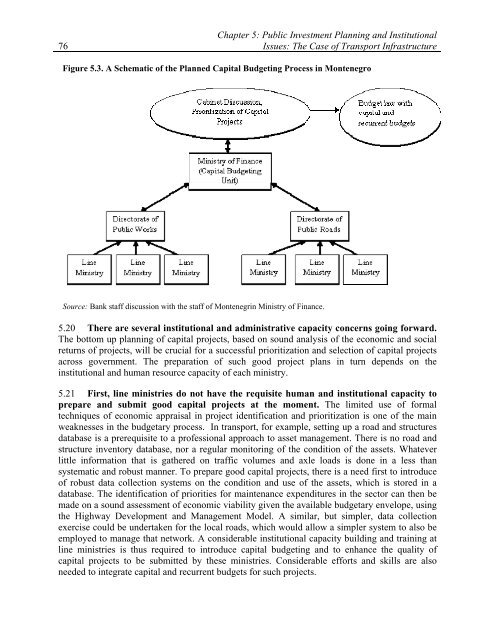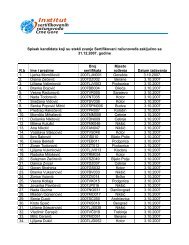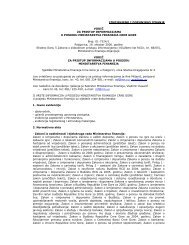Republic of Montenegro: Public Expenditure and ... - Vlada Crne Gore
Republic of Montenegro: Public Expenditure and ... - Vlada Crne Gore
Republic of Montenegro: Public Expenditure and ... - Vlada Crne Gore
You also want an ePaper? Increase the reach of your titles
YUMPU automatically turns print PDFs into web optimized ePapers that Google loves.
76<br />
Chapter 5: <strong>Public</strong> Investment Planning <strong>and</strong> Institutional<br />
Issues: The Case <strong>of</strong> Transport Infrastructure<br />
Figure 5.3. A Schematic <strong>of</strong> the Planned Capital Budgeting Process in <strong>Montenegro</strong><br />
Source: Bank staff discussion with the staff <strong>of</strong> Montenegrin Ministry <strong>of</strong> Finance.<br />
5.20 There are several institutional <strong>and</strong> administrative capacity concerns going forward.<br />
The bottom up planning <strong>of</strong> capital projects, based on sound analysis <strong>of</strong> the economic <strong>and</strong> social<br />
returns <strong>of</strong> projects, will be crucial for a successful prioritization <strong>and</strong> selection <strong>of</strong> capital projects<br />
across government. The preparation <strong>of</strong> such good project plans in turn depends on the<br />
institutional <strong>and</strong> human resource capacity <strong>of</strong> each ministry.<br />
5.21 First, line ministries do not have the requisite human <strong>and</strong> institutional capacity to<br />
prepare <strong>and</strong> submit good capital projects at the moment. The limited use <strong>of</strong> formal<br />
techniques <strong>of</strong> economic appraisal in project identification <strong>and</strong> prioritization is one <strong>of</strong> the main<br />
weaknesses in the budgetary process. In transport, for example, setting up a road <strong>and</strong> structures<br />
database is a prerequisite to a pr<strong>of</strong>essional approach to asset management. There is no road <strong>and</strong><br />
structure inventory database, nor a regular monitoring <strong>of</strong> the condition <strong>of</strong> the assets. Whatever<br />
little information that is gathered on traffic volumes <strong>and</strong> axle loads is done in a less than<br />
systematic <strong>and</strong> robust manner. To prepare good capital projects, there is a need first to introduce<br />
<strong>of</strong> robust data collection systems on the condition <strong>and</strong> use <strong>of</strong> the assets, which is stored in a<br />
database. The identification <strong>of</strong> priorities for maintenance expenditures in the sector can then be<br />
made on a sound assessment <strong>of</strong> economic viability given the available budgetary envelope, using<br />
the Highway Development <strong>and</strong> Management Model. A similar, but simpler, data collection<br />
exercise could be undertaken for the local roads, which would allow a simpler system to also be<br />
employed to manage that network. A considerable institutional capacity building <strong>and</strong> training at<br />
line ministries is thus required to introduce capital budgeting <strong>and</strong> to enhance the quality <strong>of</strong><br />
capital projects to be submitted by these ministries. Considerable efforts <strong>and</strong> skills are also<br />
needed to integrate capital <strong>and</strong> recurrent budgets for such projects.
















